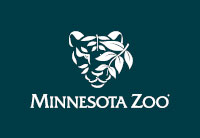Minnesota Bison Conservation Herd
Bison are North America’s largest land mammal and have been present on the landscape for many thousands of years. Once widespread across the continent, bison were hunted to near extinction during the 19th century. Bison herds today represent a small but critical fraction of their historical numbers. The Minnesota Zoo is partnering with organizations and agencies across the region to help restore this iconic animal to the landscape it calls home.
Make a donation to support more conservation initiatives like this.

What threats do bison face today?
Plains bison have ranged across North America for many centuries, once numbering in the tens of millions. Unfortunately, bison were hunted to near extinction by European settlers in the nineteenth century. By the early 1900s, it is estimated that as few as 500 individuals remained.
 Due to the conservation efforts of a few organizations and individuals, bison were saved from total extinction in the wild. Managed breeding and reintroduction efforts across the continent have helped rebuild populations and bring their numbers back to relatively stable levels. Today, there are an estimated 20,000 plains bison in conservation herds and an additional 420,000 managed commercially. While conservation efforts have been largely successful, bison numbers remain a small fraction of their historical extent.
Due to the conservation efforts of a few organizations and individuals, bison were saved from total extinction in the wild. Managed breeding and reintroduction efforts across the continent have helped rebuild populations and bring their numbers back to relatively stable levels. Today, there are an estimated 20,000 plains bison in conservation herds and an additional 420,000 managed commercially. While conservation efforts have been largely successful, bison numbers remain a small fraction of their historical extent.
During the remarkable comeback of bison in North America, a silent genetic threat was introduced. Domestic cattle were allowed to interbreed with many of the protected herds, changing the character of the American plains bison genome. The effects of this crossbreeding on bison populations are relatively unknown, but it may alter the appearance and adaptability of a species that has existed for thousands of years. It is estimated that less than one percent of the world’s remaining American plains bison have tested free of cattle genes.
Why are bison important?

Bison are considered a keystone species and play a critical role in the health of the prairies they roam. Their grazing creates nesting habitat for birds and their wallows (shallow depressions in the ground) fill with rainwater, creating habitat for amphibians and drinking water for other mammals and birds. As bison roll in the dust and mud their thick coat collects with seeds which are dispersed as the animals move. In addition, bison carrion is an important food and nutrient source for many other animals. Bison are a migratory species and can travel many miles in a single season, shaping the landscape wherever they roam.
Bison also hold significant meaning for many Tribal Communities in North America who depended on these animals for food, shelter and many other uses. This close relationship was nearly severed upon European colonization and its legacy continues today.
What is the Minnesota Zoo doing to help?
The Minnesota Zoo has collaborated with the Parks and Trails Division of the Minnesota Department of Natural Resources (DNR) to create the Minnesota Bison Conservation Herd and conserve the American plains bison throughout the state. A joint herd of American plains bison that has tested largely free of cattle genes is being managed cooperatively at Blue Mounds State Park, Minneopa State Park, Oxbow Park & Zollman Zoo, Spring Lake Park Reserve and at the Minnesota Zoo. Minnesota Zoo staff coordinate the genetic testing and pedigree tracking of the bison and work with our partners to ensure the health and long-term viability of the herd.
Key Zoo Staff:
Mary Mallinger, Conservation Biologist
Dr. Seth Stapleton, Director of Conservation and Research
Ben Sutton, Zookeeper, Northern Trail
Key Partners:
Minnesota Department of Natural Resources
Dakota County Parks
Oxbow Park & Zollman Zoo
Funding and Support:
![]()




